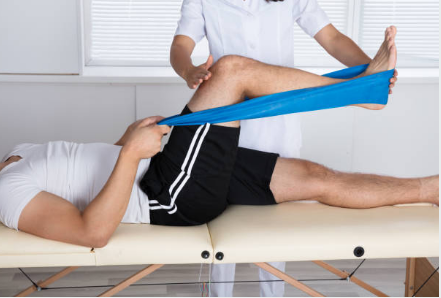A meniscus tear is one of the most common knee injuries, affecting athletes and non-athletes alike. This injury can significantly impair mobility and quality of life if not treated properly. The meniscus is a C-shaped piece of cartilage in the knee that acts as a shock absorber between the thigh bone (femur) and shin bone (tibia). There are two menisci in each knee—one on the outer edge (lateral) and one on the inner edge (medial). Understanding the causes, symptoms, and treatment options for meniscus tears, particularly the importance of physiotherapy, is crucial for effective recovery and long-term knee health.

Causes of a Meniscus Tear
Meniscus tears can occur due to various factors, often categorized into acute and degenerative causes:
- Acute Injuries:
- Sports Activities: Meniscus tears are frequently seen in sports that involve sudden stops, pivots, and turns, such as soccer, basketball, and tennis. The injury often occurs when an athlete twists their knee while their foot is planted on the ground.
- Trauma: Direct trauma to the knee, such as a fall or collision, can cause a meniscus tear. This is common in contact sports like football and rugby.
- Degenerative Changes:
- Aging: As we age, the meniscus becomes less flexible and more prone to tears. Degenerative meniscus tears are more common in individuals over 40, often resulting from minor movements or minimal trauma.
- Osteoarthritis: People with osteoarthritis are at a higher risk of meniscus tears due to the weakening and thinning of the cartilage over time.
Symptoms of a Meniscus Tear

The symptoms of a meniscus tear can vary depending on the severity and location of the tear. Common symptoms include:
- Pain:
- Pain on the inner or outer side of the knee, often exacerbated by twisting or rotating the knee.
- Swelling:
- Swelling around the knee joint usually develops gradually over a few hours after the injury.
- Stiffness and Limited Range of Motion:
- Difficulty bending or straightening the knee fully, accompanied by a feeling of stiffness.
- Locking or Catching Sensation:
- A sensation that the knee is locked in place or catches during movement.
- Instability:
- The knee may feel unstable or give way, especially when walking on uneven surfaces.
- Popping Sensation:
- Some individuals may feel or hear a popping sensation at the time of injury.
Diagnosis of a Meniscus Tear

Proper diagnosis of a meniscus tear involves a combination of physical examination and imaging techniques:
- Physical Examination:
- A healthcare provider will assess the knee’s range of motion, stability, and areas of tenderness. Specific tests, like the McMurray test, may be performed to check for meniscus tears.
- Imaging:
- X-rays: While X-rays can’t detect meniscus tears, they help rule out other causes of knee pain, such as fractures or arthritis.
- MRI: Magnetic Resonance Imaging (MRI) is the most effective imaging technique for diagnosing meniscus tears, providing detailed images of the knee’s soft tissues.
Treatment Options for a Meniscus Tear

The treatment for a meniscus tear depends on the size, location, and severity of the tear, as well as the patient’s age, activity level, and overall health. Treatment options range from conservative approaches to surgical intervention:
- Conservative Treatments:
- Rest: Avoiding activities that exacerbate the pain and giving the knee time to heal.
- Ice: Applying ice packs to reduce swelling and pain.
- Compression: Using a knee brace or bandage to provide support and reduce swelling.
- Elevation: Keeping the leg elevated to minimize swelling.
- Medications: Over-the-counter pain relievers like ibuprofen or acetaminophen to manage pain and inflammation.
- Physiotherapy:
- Physiotherapy is a cornerstone in the treatment of meniscus tears, playing a vital role in both non-surgical and post-surgical recovery. A physiotherapist will design a personalized rehabilitation program to restore knee function, improve strength, and prevent future injuries.
- Surgical Treatments:
- Arthroscopic Surgery: This minimally invasive procedure involves inserting a small camera and instruments through tiny incisions to repair or remove the damaged part of the meniscus.
- Meniscus Repair: Suitable for younger patients or those with tears near the outer edge of the meniscus where blood supply is better, allowing for healing.
- Meniscectomy: Removal of the damaged meniscal tissue, often recommended for degenerative tears.
The Importance of Physiotherapy in Meniscus Tear Treatment
Physiotherapy is essential in managing meniscus tears, whether treated conservatively or surgically. Here’s how physiotherapy contributes to recovery:
- Pain Management:
- Physiotherapists use modalities like ice, heat, and electrical stimulation to reduce pain and inflammation.
- Restoring Range of Motion:
- Gentle stretching and mobilization exercises help restore the knee’s range of motion, preventing stiffness and improving flexibility.
- Strengthening Muscles:
- Strengthening the muscles around the knee, particularly the quadriceps and hamstrings, is crucial for stabilizing the joint and preventing future injuries. Physiotherapists guide patients through tailored strengthening exercises.
- Improving Balance and Proprioception:
- Exercises to enhance balance and proprioception (the body’s ability to sense its position in space) are incorporated to improve knee stability and function.
- Functional Training:
- Functional training focuses on restoring the ability to perform daily activities and sports-specific movements. This helps ensure a safe return to normal activities and sports.
- Preventing Recurrence:
- Education on proper body mechanics, knee protection strategies, and injury prevention techniques helps reduce the risk of future meniscus injuries.
Meniscus tears, while common, can significantly impact an individual’s quality of life. Understanding the causes and symptoms of a meniscus tear is the first step toward effective treatment and recovery. Whether through conservative measures or surgical intervention, physiotherapy plays an indispensable role in the rehabilitation process. By managing pain, restoring range of motion, strengthening muscles, and improving functional capabilities, physiotherapy ensures a comprehensive approach to recovery, helping individuals regain their mobility and return to their daily activities with confidence. If you suspect a meniscus tear, seek prompt medical advice to determine the best course of action for your specific condition and embark on a well-structured rehabilitation journey with the guidance of a skilled physiotherapist.






